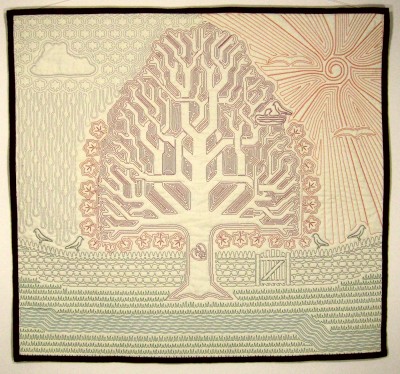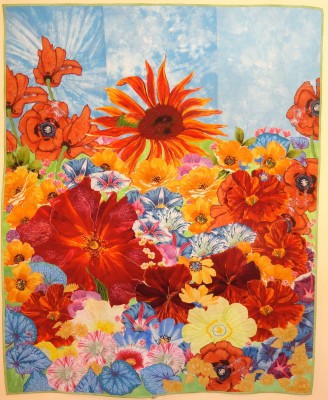Jarree Donnelly contends that contemporary art quilts are a true art form, as worthy of appreciation as painting or sculpture. And as the Arts Barn’s gallery coordinator, she has curated an exhibit that proves her point. “Contemporary Quilters: A Modern View of Life,” featuring the work of eight fiber artists, is the visual aspect of “an entire art experience for our patrons,” she said. The program also has an educational component–master classes on April 9 and 16, and a performing one–an April 1-17 production of the musical “Quilters” by Rockville Musical Theatre.
“We chose to show fiber art for several reasons,” Donnelly said, chief among them that they “are beautiful and technical. … Contemporary quilters have become so creative in what they are doing … using textiles in new and exciting ways and exploring unique techniques, even including digital technology.”
“Quilting has evolved,” Donnelly observed, “and is no longer what we remember our grandmothers doing–piecing work to create traditional block patterns, although the traditions still exist and will hopefully continue.” The musical “Quilters,” she explained, showcases those traditions as embodied in the lives of pioneer women who express the stages of their lives in quilt blocks. She said by showing their work, the visual artists, too, are sharing their lives.
To curate the “Contemporary Quilters” exhibit, Donnelly enlisted former Arts Barn resident artist Lauren Kingsland—an art quilter who is now a resident artist at The Sandy Spring Museum. Kingsland, who curated quilt shows in Gaithersburg City Hall for about a decade, “was able to help connect us with some of the most amazing fiber artists that are working and exhibiting in our region. We viewed their work, sent out invitations and were so pleased that the majority of the artists were available to exhibit with us at the time we had selected and excited to be part of the exhibit.”
Kingsland, who has seven pieces in the show, echoed Donnelly’s comments on quilts as art. Maintaining a public studio, first in the Arts Barn, and now at the museum, she said, “was a chance for quilts to be part of the conversation about arts in the community along with painting, sculpture, stained glass, music, dance, theater, etc. …It’s been part of just owning and declaring quilts to be art, and no one disagrees.”
Introduced to quilt-making as a child by her grandmother, Kingsland belonged to a quilters guild “during the surge of interest in quilting that accompanied the 1976 Bicentennial,” and after moving to Maryland in 1984, found community in the Gaithersburg-based Friendship Star Quilters Guild. A turning point occurred two years later when she saw Frank Stella’s painting of concentric squares in two color progressions at the National Gallery of Art. “It looked like something that could be sewn, and I knew that quilts ought to be considered an art medium when there was something to say,” she recalled. And it motivated her to study color, design, drawing and watercolor “to learn to talk to the art world, and to improve my own quilt-making so it could be art.” She will lead the April 16 workshop, “Quilting with Your Own Voice.”

Margaret Hartranft’s first project consisted of five Log Cabin quilts from a printed pattern in a Women’s Day magazine in 1977. Having majored in home economics education at Ohio State University, she taught sewing and quilting techniques at a Stretch and Sew Store in Virginia in the 1980s, and joined a guild that issued an annual original quilt challenge. In the resulting quilt, “Derwood, don’t play in the traffic,” the artist intermingled rubbings of three manhole covers with light beams from car headlights; a local civic alliance used it to protest development of the Intercounty Connector (ICC). Realizing she prefers “to interpret things I see in my travels, things I think about, and to use techniques and skills I’ve learned to put those thoughts into fabric,” Hartranft often uses her photographs, “printing or having them printed onto fabric, then combining those images into the quilt.” In two of her three pieces in the exhibit, she collaged the photos.
Anne Smyers sewed during her youth, but abandoned it until 2007 when she took a quilting class at G-Street Fabrics. Hooked, she “continued to take classes and make quilts,” recognizing shortly afterwards that experimenting with and designing her own creations was much more interesting than using patterns. After two solo shows, “I began to think of myself as an artist,” Smyers said. “Eventually, enough other people encouraged and affirmed the work I was doing that my perspective shifted … Certainly the intentionality and discernment I was putting into my work at this point was supporting my growing confidence.”
The two large pieces Smyers has in the exhibit use flowers as a repetitive motif. “As I’ve worked with them more and more, I’ve thought about how flowers are the ultimate expression of the plant in both its most open and receptive state,” she said. “I like that metaphor as representative of what quilting and fiber art means to me. It’s an avenue for expression for me.” Most recently, Smyers, who has been using flowers to create mandalas, “radial circular designs that can be seen as representing the universe,” will lead the April 9 workshop “Floral Mandala Quilt.”

Displaying the quilts was a challenge. Donnelly knew the standard gallery equipment would not work, and the Gaithersburg Arts and Monument Funding Corporation helped fund the necessary hooks. “We chose to install the exhibit using clear line, so the quilts seem to almost float in the space and there is no distraction from their beauty,” she said. “The trick is that careful measurements have to be taken for each quilt to hang properly and this takes a lot of time. It took us a day and a half to install the 39 pieces on exhibit, but we love how it turned out.”
Donnelly is delighted with visitors’ reactions. “As patrons enter the front door, they are stopping in their tracks and we are getting a lot of ‘wow!’ There is nothing more satisfying when you work in a gallery to have people really enthusiastic about what you have chosen to share with them.”